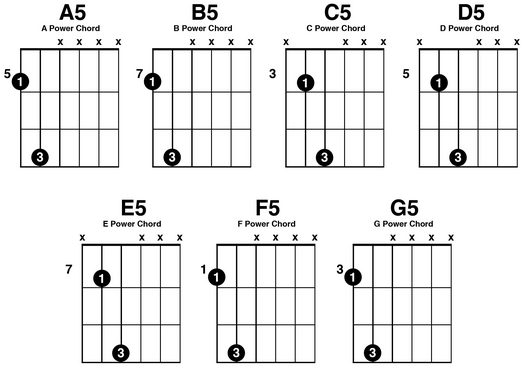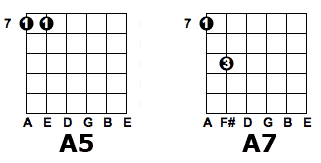Drop D Tuning for Guitar
Plus Other Alternate Tuning Methods
Most new players learn with standard tuning (E-A-D-G-B-E). Others, such as Drop D Tuning, provide a unique sound, simplify some chord forms, make very fast power chord progressions possible, and introduce something new into your learning and playing. Why not try it?
The reason this particular tuning method is called Drop-D is because you literally drop the tuning of one of your strings to the pitch of D. That is, you drop the pitch to D. Your guitar is now tuned to D-A-D-G-B-E. Make sense?
Most people who use this alternate tuning method change the pitch of the sixth string only, the low E, from E to D. This is frequently used for Rock songs when you want a darker tone, such as with Heavy Metal. In addition, dropping the E string two steps to D means that you can play power chords with one finger. Some people also drop the first string (high e) down to D, resulting in D-A-D-G-B-D.
Quick Reference!
- Most often Drop D tuning involves tuning only the sixth string (low D) down to D.
- Many Rock, Heavy Metal, or songs with a dark tone use this alternate tuning method.
- Use an electronic tuner, or re-tune the E string by ear using the D string (3rd string).
- Play power chords easily with one-finger barre'd across two (or three) strings. Simply place your index finger over the sixth & fifth stings at the same fret. (You can also barre the 4th string, which is also a D, and will match the root of your chord one octave higher.) The resulting power chord is named after the note played on the sixth string. At the first fret, it's D#5, at the third fret, it's F5. For tunes blues-rock tunes that use a lot of 5 & 7 power chords, such as those made famous by Chuck Berry, Drop D tuning allows you to play those 7 chords as though they were normal power chords.
Getting It Done
Tuning the E string down two steps is easily done with an electronic tuner. Begin with standard tuning (E-A-D-G-B-A), then simply loosen the sixth string until the note shown on your tuner is D (remember to tune past D, to Db or C#, and then tune back up to D to ensure proper tuning).
Tuning the E string by ear is also fairly easy. First, pluck the fourth string (D) and then beginning loosening the E string until the two notes sound similar. Some would describe this sound as "in phase". The two notes will be an octave apart, but you should be able to hear when they produce the same note.
Why Do Same Fret Power Chords Work?
A power chord is shorthand for playing only the root and the fifth notes of a chord. Frequently you see a chord notation written like this: C5. This means: play the root and the fifth notes only. The notation C5 is pronounced either "C-Five" or "C power chord."
For more on power chords, see Tip 5 on the Easy Guitar Tips page.
Power chords are normally played on strings that are side by side, two frets apart. Below is a chart of a few power chords.

Common Power Chords With Standard Tuning.
Consider the A5 (A power chord), which is composed of the notes A and C.
With standard tuning, you might play the A at the fifth fret of the E string and the C on the seventh fret of the A string (as shown in the diagram, above).
When you are in Drop D tuning, the note open string is a D. This means that at fifth fret you would play a G. To get the A note (the root of the power chord) you would move up to the seventh fret. How convenient that the fifth is right next to it, on the seventh fret of the next string! Power chords now look like the following chart. Note the difference between these chords and those in the previous chart.

Sample Power Chords With Drop D Tuning.
Notice also, in the following diagram, how easy it becomes to play a five-chord followed by a seven-chord. No more stretching your hand uncomfortably.

Note The Easy Stretch To The 7 Chord In Drop D
Double Drop D Tuning And DADGAD
To use double Drop D tuning, simply tune both E strings (the first string and the sixth string) down to D. If you are going to do this, you might as well try DADGAD tuning as well, in which you also tune the second string down two half-steps to A.
DADGAD tuning can be used to quickly and easily play a number of major and minor chords. This tuning is traditionally used with acoustic guitar, but has been used for a number of Rock songs, most notably U2 songs.
For more information on Double Drop D or DADGAD tuning, search the Internet and you are certain to find numerous articles.

Are There Strings Made For Drop D Tuning? YES!
DR Strings makes strings that were specifically designed for drop d tuning, other alternate tunings, and even standard tuning. Known as DDT strings, DR spent over two years perfecting them. DR created a new patent pending method for constructing these strings to ensure great performance with lower pitches. Because of the amazing construction, and their ability to quickly lock into tune so quickly, DR calls their DDT's "Superstrings". Why not try a set? DDT's are available for electric guitar or bass guitar.
Songs That Use Drop D Tuning
There are a number of songs that use Drop D tuning. Here is a short list to give you an idea of how widely this tuning is used.
- "Heart Shaped Box" by Nirvana;
- "Moby Dick" by Led Zepplin
- "Cinnamon Girl" by Neil Young (Double Drop D)
- "Dear Prudence" by The Beatles
- "Everlong" by Foo Fighters
- "Higher" by Creed
- "Soundgarden" by Black Hole Sun
Reinforce Your Learning Visually
Here is a nice introduction to Drop-D tuning from our friends at D'Addario. In addition to showing you how to tune down to D on the 6th string, the instructor also shows how powerful this technique is for playing power-chords and mixing in riffs.


